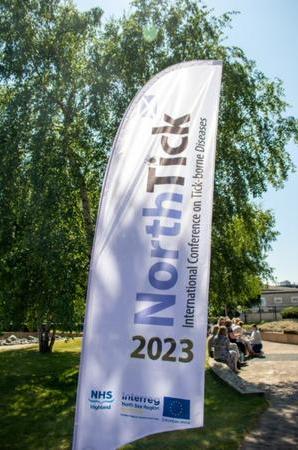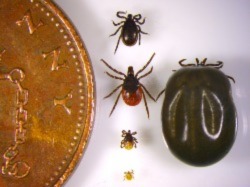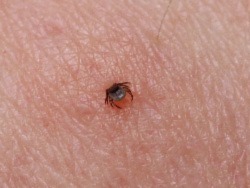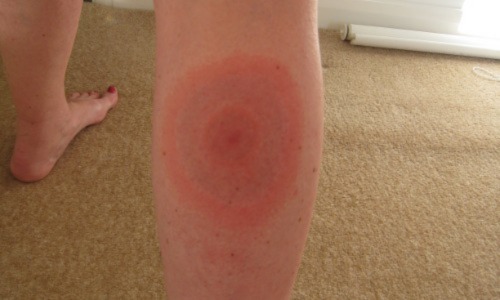Highlights from NorthTick 2023
Posted on August 9, 2023 by Dr Azul Zorzoli
Dr Azul Zorzoli takes us through the highlights of NorthTick 2023.
The NorthTick project is a collaborative effort among several countries, including Scotland, Denmark, Sweden, Norway, Germany, Belgium, and the Netherlands. Its goal is to address the challenges related to tick-borne diseases through a multi-disciplinary approach. NorthTick is also the name of their recent conference held in Inverness, Scotland, between May 30th and 31st, 2023. The event was organised in three sessions dedicated to epidemiology, diagnosis and management of tick-borne diseases.

During the “Risk and prevention of tick-borne diseases” session, Keynote Speaker Dr Patrick Leighton, from the Canadian Lyme Disease Research Network, discussed the impact of climate change on tick populations, transmission of tick-borne pathogens and the burden of tick-borne diseases in Canada. Dr Sophie Vanwambeke from Université catholique de Louvain, Belgium presented data on the climate and environmental changes driving the geographical expansion of Ixodes ricinus, the primary vector for European tick-borne diseases.
Several Belgian, Dutch, and Scottish speakers provided evidence of Lyme disease-causing ticks in unexpected geographical areas, including urban parks and domestic gardens. For example, 87% of tick-trapped surveyed park plots in Antwerp, Belgium, had at least one Borrelia-infected tick. The presence of these ticks decreased with urbanisation but increased in areas connected to propagation hosts such as hedgehogs, raccoons, small rodents, birds and deer. A survey in Belgium revealed that half of the ticks found in gardens were infected with Borrelia species, although not all posed a risk to humans. Kayleigh Hansford and Zoe Gibney from the UK Health Security Agency presented their “tick-bite risk indicator”, a data-driven approach to assess Lyme disease exposure risk in England based on the disease incident rates and the records on tick populations.
In the “Laboratory diagnosis” session, Dr Lesley Bell-Sakyi, director of the Tick Cell Biobank at the University of Liverpool, UK, gave an overview of tick-borne disease research and the laborious protocol for generating tick cell lines for culture, which can take up to seven years. Dr Guro Funset Jensen, from Sørlandet Sykehus, Norway, discussed the challenges in Lyme diagnosis and the limited clinical value of borreliosis serum IgM with or without IgG pairing. Dr Antonio Foddai from the University of Aberdeen, UK, presented a novel peptide-based assay to differentiate Borrelia burgdorferi sensu stricto from B. garinii and B. afzelii. The first is the principal causative agent for Lyme borreliosis in North America, whereas the other two are more common in Europe.

|

|
| © Medical Entomology & Zoonoses Ecology Group, UKHSA Life stages of Ixodes ricinus, Europe's most common tick species. From top to bottom: adult male, adult female, nymph and larva. An engorged female is shown on the right. | © Medical Entomology & Zoonoses Ecology Group, UKHSA An image of an Ixodes ricinus nymph penetrating human skin to feed. During this process, the bacteria responsible for Lyme Disease, Borrelia burgdorferi, can infect its host |
Dr Christine Wenneras from the Sahlgrenska University Hospital, Sweden, discussed recent diagnostic tools for emerging pathogens. In addition to the well-known Borrelia burgdorferi sensu lato complex and the tick-borne encephalitis virus, Ixodes ricinus can also transmit anaplasmosis, neoehrlichiosis and spiroplasma and cause Borrelia miyamotoi disease, Rickettsia helvetica infections, and babesiosis. Currently, these species are diagnosed through PCR and 16S rRNA sequencing. There are only a few serology options available for diagnosis, and since most of these are intracellular pathogens, routine culture tests are ineffective. Therapeutics were briefly discussed, highlighting the need for antibiotics capable of penetrating mammalian cells to treat these infections.
Dr Hanne Quarsten, from Sørlandet Sykehus, Norway, discussed the prevalence of underdiagnosed tick-borne diseases in the North Sea Region. The rate of infected ticks with Anaplasma phagocytophilum and Borrelia miyamotoi ranges between 1–5%. Ticks in Germany and the Netherlands have the highest Rickettsia helvetica and Neorliechia mikurensis prevalence, ranging between 10–25%. In terms of infections to humans, the NorthTick consortium has estimated fewer than 300 confirmed cases of anaplasmosis, 200 of neoehrlichiosis, 60 of babesiosis, and less than 10 of B. miyamotoi and R. helvetica infections in Europe.
The third session, “Management of tick-borne diseases,” was led by Dr Alice Raffetin from the Tick-Borne Diseases Reference Center in France and Dr Randi Eikeland from Sørlandet Hospital, Norway. The speakers discussed different clinical pictures of Lyme disease and highlighted that mild or asymptomatic presentations in healthy individuals are not uncommon. For instance, about half of the patients diagnosed with Lyme Disease do not exhibit the hallmark skin rash erythema migrans. Thus, the absence of this manifestation should not be used to rule out exposure. The discussion continued on effective strategies for managing Lyme disease in patients with compromised immune systems and those who continue to experience symptoms even after adequate antibiotic treatment, a condition referred to as Post-Treatment Lyme Disease Syndrome.

It is widely agreed that Tick-borne infections will likely be underdiagnosed due to their subtle symptoms, limited availability of local diagnostic services, low prevalence, and a lack of familiarity among clinicians. NorthTick showcased cutting-edge research and promising avenues for improved diagnostic techniques and targeted prevention strategies. The collaboration fostered among healthcare professionals, researchers, and policymakers during this conference paves the way for integrated efforts in combating tick-borne diseases.
Thanks to Dr Sally Mavin, Director of the Scottish Microbiology Reference Laboratory (SMiRL), for her helpful feedback on this article.
Thumbnail Image: Keynote speaker Dr Lesley Bell-Sakyi opening the Laboratory Diagnostic session at NorthTick 2023. Dr Bell-Sakyi is a Senior Research Fellow and Manager of the Tick Cell Biobank at the University of Liverpool, which holds the most extensive collection of cell lines originating from ticks and other arthropods. Credit: NorthTick 2023 Conference.
Banner Image: Ticks don't jump nor fly; they quest. Questing involves ticks climbing up plants, extending their front legs, and waiting for an opportunity to attach themselves to a passing host. The image shows a female Ixodes ricinus tick questing on vegetation. Credit: Medical Entomology & Zoonoses Ecology Group, UKHSA

